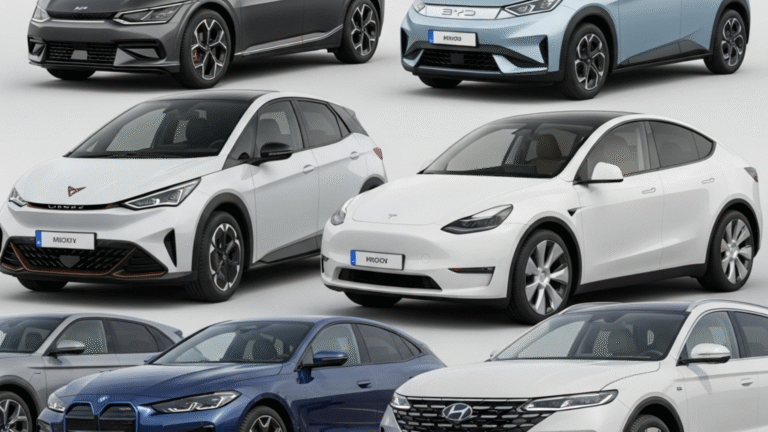If you live in Sydney, Melbourne, Brisbane—or any Australian city—small EVs tick a lot of boxes: tight parking, low running costs, strong creature comforts for short commutes and the ability to nip in and out of dense traffic. In 2025 there are several compact electric cars that finally bridge the gap between affordability and usability. This guide highlights what matters for city drivers in Australia and recommends the best small EVs to try, with practical ownership tips.
Table of Contents
- What “small EV” means in 2025
- Why small EVs are perfect for Australian cities
- Best small EVs to test-drive this year (with key reasons)
- Real-world ownership: charging, range and running costs
- Practical buying checklist for city drivers
- Everyday tips for living with a small EV in the city
- FAQs
1. What “small EV” means in 2025
A small EV is typically a hatchback or compact crossover with:
- A footprint that’s easy to park and manoeuvre.
- Usable real-world range for daily urban use (200–350 km).
- Efficient motors and often single-motor drivetrains that keep costs down.
- A compact battery pack that balances price and weight.
These cars prioritise convenience and economy over outright performance, but 2025 models are also surprisingly feature-rich.
2. Why small EVs are perfect for Australian cities
- Parking & agility: Narrow streets and tight garages reward smaller turning circles and compact length.
- Daily range is usually plenty: Most urban drivers average 30–80 km/day—well within the capability of modern small EVs.
- Lower total cost of ownership: Smaller batteries cost less to replace, consume less energy, and often attract lower insurance premiums.
- Ideal for apartment living: When paired with workplace or destination charging, small EVs remove the need for a private wallbox in some cases.
For someone who prioritises convenience and low running costs, a small EV often makes more sense than a larger, pricier model.
3. Best small EVs to test-drive this year (with key reasons)
(Models listed as archetypes and what they deliver — test drives are essential.)
- Efficient City Hatch — Supremely easy to park, exceptional regen for one-pedal driving and a tight turning circle. Ideal if most driving is inner-city or across short suburbs.
- Value-Packed Compact — Small battery but rich standard equipment and a well-tuned chassis; delivers the most “tech per dollar.”
- Long-Range Compact — Slightly higher cost, but durable thermal management and stronger DC charging acceptance; makes occasional regional trips comfortable.
- Compact Crossover — A taller ride and more space for weekend gear with similar urban agility. Great for small families who want flexibility.
When test-driving, prioritise regen behaviour, charging port ergonomics and real-world boot usability.
4. Real-world ownership: charging, range and running costs
- Home charging: If you can install a 7 kW wallbox, expect an overnight full charge from empty in 4–8 hours depending on battery size. Nightly off-peak tariffs are the cheapest running cost.
- Public charging: Small EVs benefit most from Level 2 public chargers for top-ups; frequent fast-DC use can add cost without large time savings for short trips.
- Running costs: Expect significant savings relative to petrol cars—less maintenance, no oil changes, regenerative braking reduces brake wear. Insurance and tyres remain standard costs; budget for occasional software subscriptions if the manufacturer offers them.
A small EV is often cheapest if home charging is available; renting or apartment living shifts reliance to public/destination charging.
5. Practical buying checklist for city drivers
- Real-world range check: Ask dealers for a real-world figure under mixed suburban conditions.
- Boot aperture & load lip: Confirm you can fit the items you frequently carry.
- Charger ergonomics: Make sure the charging port and cable length work for your parking spot.
- App & payment simplicity: Test the manufacturer’s app and public-charging apps you plan to use.
- Warranty & dealer network: Smaller brands can be good value but check local service access.
If you rely on street parking, measure cable reach from likely parking to power source before committing.
6. Everyday tips for living with a small EV in the city
- Use one-pedal driving to reduce stops and increase regen gains.
- Schedule charging during off-peak tariffs or charge at work if possible.
- Keep a compact tethered cable or Type 2 portable EVSE in the boot for ad-hoc destination charging.
- Join a local EV owners’ group—city knowledge (charger reliability, best cafes with chargers) is gold.
Small EVs are about low friction in daily life—small changes in routine unlock big benefits.
FAQs
Q: Is a small EV enough for weekends away?
A: Yes—if you choose one with decent DC charging acceptance and plan your stops. For frequent long trips, pick the long-range compact archetype.
Q: Are small EVs more affordable to insure?
A: Often yes—smaller cars typically attract lower premiums, but check quotes. Insurance varies by area and driver history.
Q: What’s the ideal battery size for city use?
A: Roughly 40–60 kWh gives a good balance of range and cost for most city drivers.
Conclusion
For Australian city drivers in 2025, small EVs are an excellent match: easy parking, low running costs and enough range for everyday life. Focus on real-world range, charging logistics, and dealer support when you test-drive. With the right small EV, commuting becomes simpler, cheaper and more enjoyable.
Meta description: Looking for a small EV for city life in Australia? Discover the best small electric cars for 2025—efficient, practical and perfect for tight urban living.
